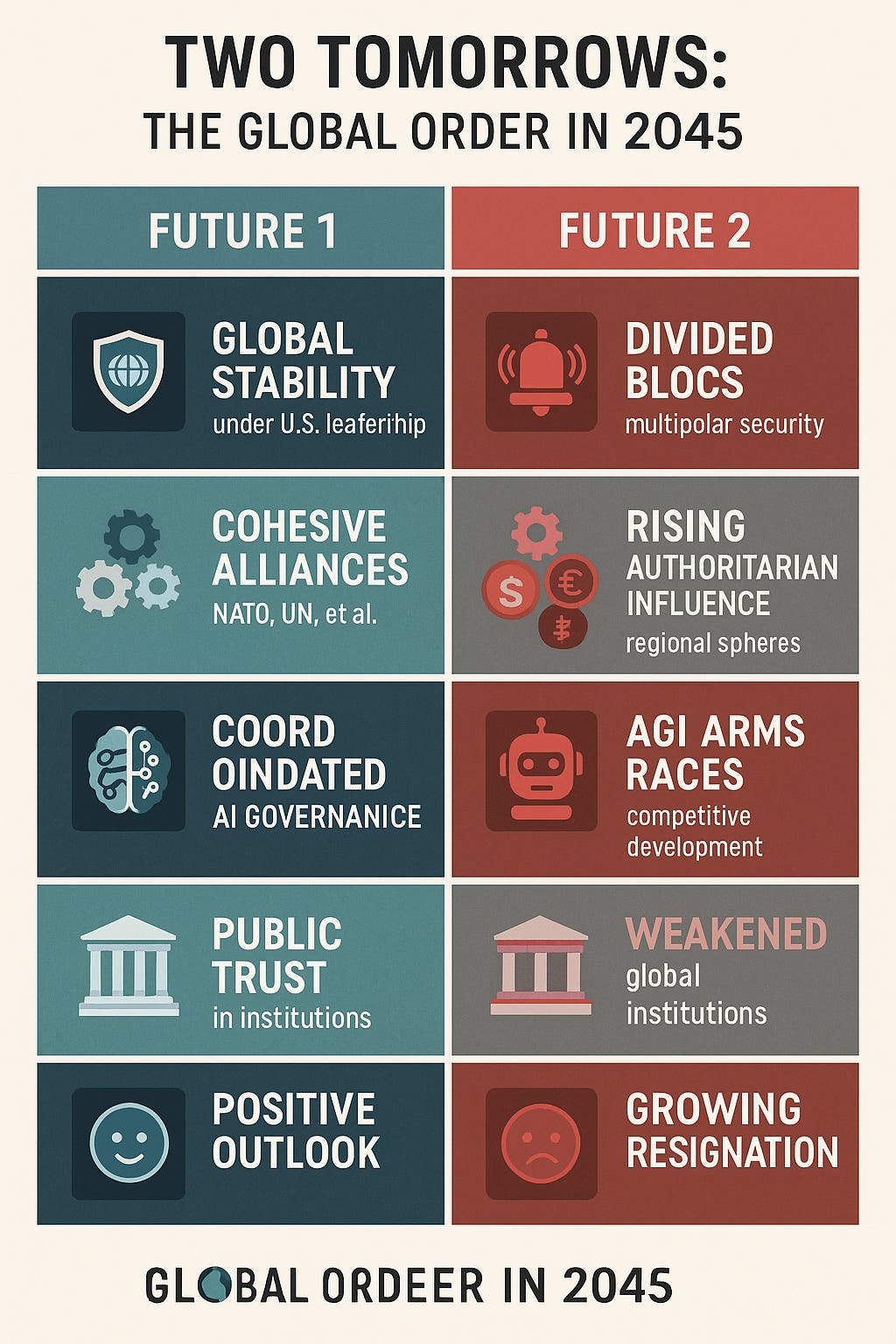INFORMATION WARFARE MAGAZINE – FEATURE SPREAD
THE STAKES: 2025 TO 2045
In the aftermath of World War II, the United States launched the most ambitious geopolitical investment in history. From the Marshall Plan and Bretton Woods to NATO and the UN, America bankrolled a rules-based order that promoted peace, prosperity, and primacy.
Then, in 2016, that course was disrupted.
President Trump redefined American strategy through nationalism, skepticism of alliances, and an anti-globalist posture. The result? A fractured global system now teetering between two starkly different futures:
One of continued American leadership, had the postwar order been sustained. And another of deepening multipolarity, if current trajectories remain uncorrected.
🌍 FUTURE 1: CONTINUITY – THE UNINTERRUPTED POST-WWII ORDER (2025–2045)
Security:
NATO expands influence, reinforcing collective defense.
U.S. troops deter aggression from Eastern Europe to the Taiwan Strait.
The U.S. remains the security linchpin for democratic alliances.
Economy:
Bretton Woods institutions (IMF, World Bank) thrive under renewed U.S. leadership.
Dollar dominance persists as America leads financial stability.
Global trade blossoms under updated TPP and WTO reforms.
Tech & AI Governance:
AGI and biotech are globally governed through U.S.-anchored alliances.
Unified frameworks ensure democratic alignment, AI ethics, and non-proliferation.
Global Norms:
U.S. foreign aid increases soft power.
Multilateralism defines crisis response—from pandemics to climate change.
Strategic Identity:
America is seen not as an empire—but a benevolent steward of global equilibrium.
Trust in liberal institutions deepens across generations.
Outcome:
A cooperative, resilient, and innovation-led world. U.S. prestige peaks. Liberal norms thrive.
⚖️ FUTURE 2: MULTIPOLARITY – THE CONTINUING DRIFT (2025–2045)
Security:
NATO weakens; Europe arms for strategic autonomy.
China, Russia, and regional blocs form their own defense spheres.
Nuclear proliferation returns in the Middle East and Asia.
Economy:
Dollar dominance erodes. CBDCs and BRICS coin gain traction.
WTO becomes irrelevant. Trade becomes fragmented and coercive.
Tech & AI Governance:
AGI development splinters into ideological silos.
China’s AI regime rivals U.S. models in closed authoritarian ecosystems.
AGI is militarized and manipulated in misinformation warfare.
Global Norms:
UN credibility collapses.
Surveillance, cyber-coercion, and digital propaganda replace diplomacy.
Strategic Identity:
U.S. seen as unpredictable and self-isolating.
Rise of transactional authoritarianism and tech-enabled soft empires.
Outcome:
A fragmented, adversarial, mistrust-driven world. Global order becomes a contest, not a consensus.
THE CONCLUSION: WHAT DID WE CHOOSE TO DEFEND?
The world order is not an inevitability—it is an asset. It requires maintenance. Investment. Leadership. Trump’s four-year disruption triggered a reevaluation of what America built—and what happens if that structure collapses.
If the U.S. had stayed its postwar course, the future would likely be more stable, prosperous, and principled. Instead, the path now points to a multipolar mosaic, where power is divided, trust is scarce, and governance is up for grabs.
The question remains:
Will we rebuild what was lost—or watch the investment of a century fade into history?












